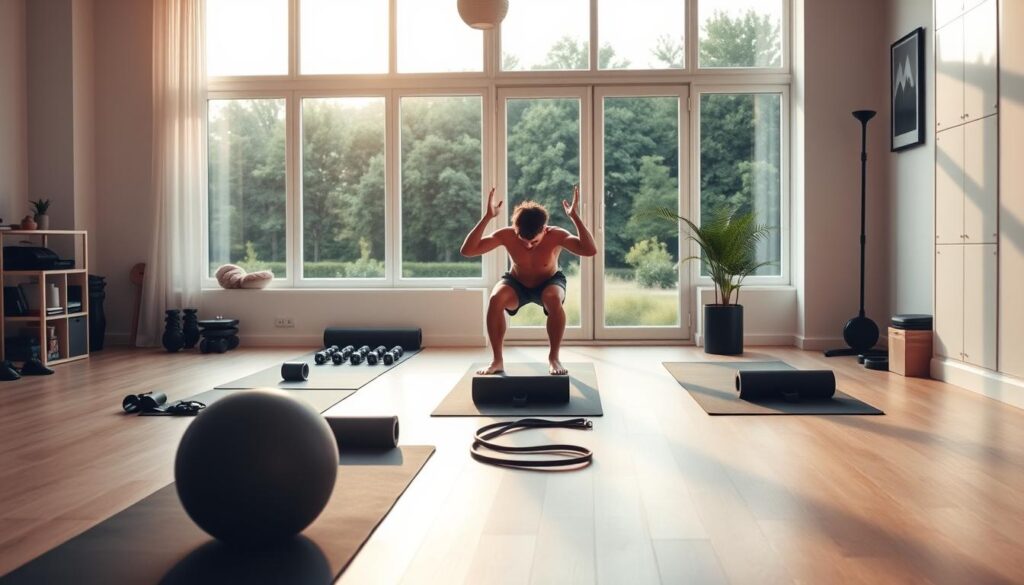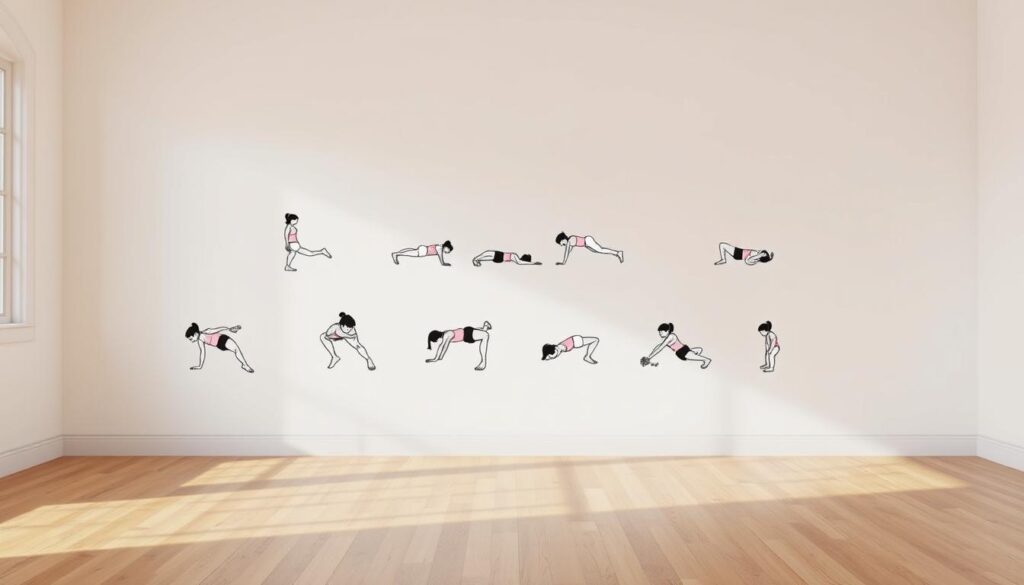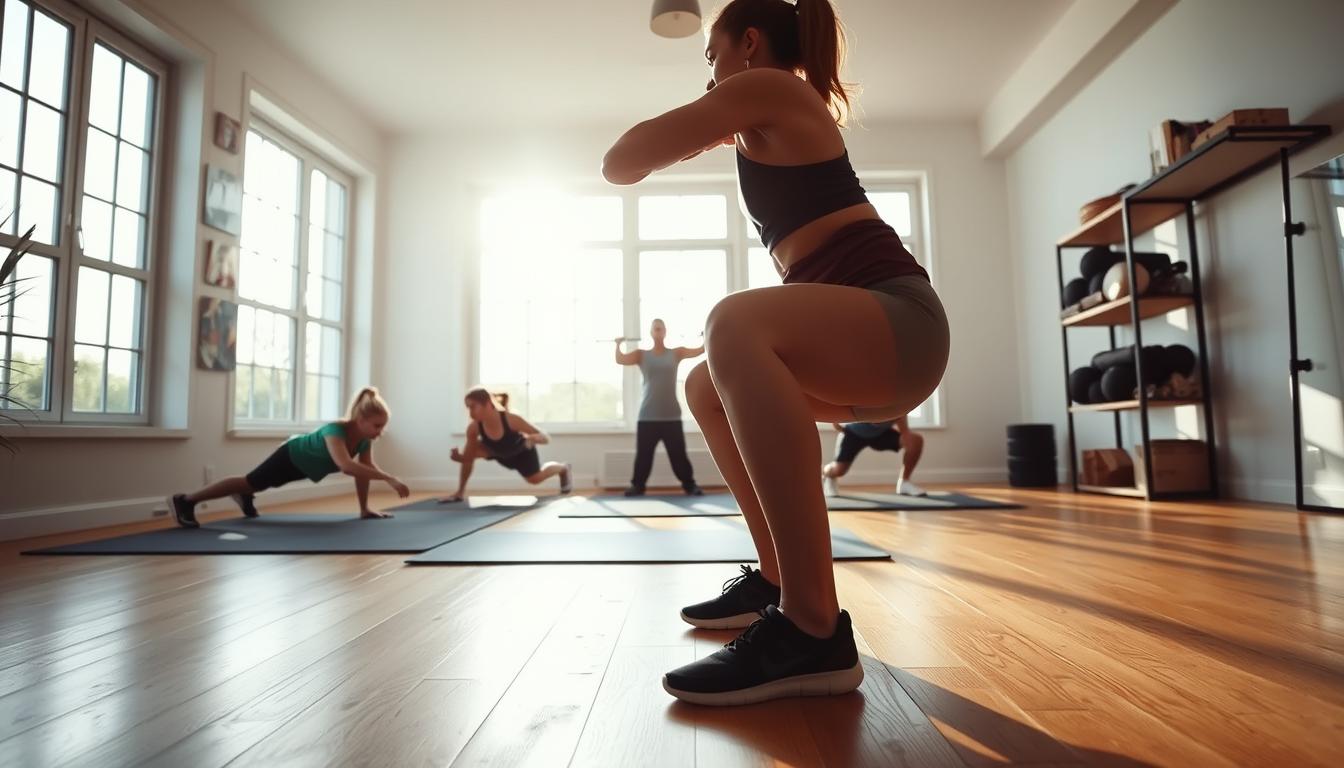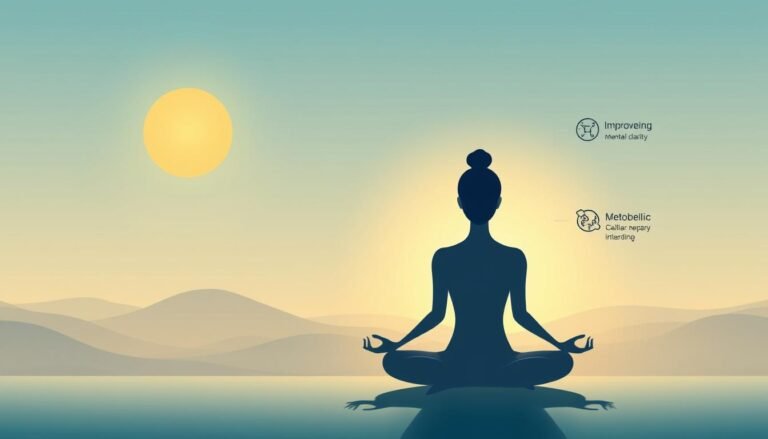Want to get fit without going to the gym or spending on fancy equipment? You can build a stronger, leaner body using just your body weight and a small space at home.
Home workouts have changed how we think about fitness. They let you build strength, boost flexibility, and improve health without expensive machines. Bodyweight exercises are a great way to reach your fitness goals.
Busy professionals, stay-at-home parents, or anyone starting a home fitness routine can benefit. Your body is the best workout tool. With the right moves, you can do full body workouts at home that really work.
Key Takeaways
- No equipment needed for effective strength training
- Bodyweight exercises can be done anywhere
- Home workouts provide maximum flexibility
- Consistent practice leads to significant fitness improvements
- Customizable routines for all fitness levels
Why No-Equipment Workouts Are Perfect for Building Strength
Discovering the power of workout without equipment can change your fitness journey. You don’t need expensive gear or gym memberships. Just use your body weight and get creative.

Your body is the best fitness equipment you’ll ever have. Home exercises for beginners are great for building muscle and improving flexibility. They also boost your overall fitness.
Benefits of Bodyweight Training
- Builds functional strength that translates to real-world movements
- Improves core stability and balance
- Reduces risk of injury by developing natural movement patterns
- Requires zero financial investment
Science Behind Equipment-Free Exercise
Research proves bodyweight exercises are as good as weight training. Resistance from your own body weight provides constant muscle tension. This is key for muscle growth and strength.
Convenience and Accessibility Factors
The best thing about a home workout plan is its flexibility. You can exercise anywhere – like your living room, bedroom, or backyard. No more excuses for missing gym time or lacking equipment.
Your body is a portable gym that never closes and doesn’t charge monthly fees.
By focusing on bodyweight movements, you build a strong fitness base. Start simple, progress gradually, and see your strength grow.
Essential Body Movements for Home Workouts

Learning essential body movements is key to great home workouts. You don’t need expensive gear or a gym to get fit. These basic exercises will make your home workouts strong and effective.
Understanding core movements is crucial for a good home workout. These movements work many muscles at once. Let’s look at the key exercises for a powerful home workout:
- Squats: The ultimate lower body exercise that targets glutes, quads, and core muscles
- Push-ups: A classic movement for upper body and core strength
- Lunges: Perfect for building leg strength and improving balance
- Planks: The ultimate core stability and full-body conditioning exercise
- Burpees: A high-intensity movement that burns calories and builds total body strength
These tips will help you create a full-body workout at home. By adding these movements to your routine, you’ll get stronger, more flexible, and fitter.
Remember, consistency is more important than perfection in your fitness journey.
Start with simple versions of these exercises and add more as you get stronger. Your body will grow stronger and more flexible with each workout. These exercises are simple yet very effective for a great home workout.
Full-Body Calisthenics Routine for Beginners
You don’t need expensive gear to build muscle at home. A total body workout with no equipment can change your fitness journey. It helps you stay fit at home with quick and easy workouts. Calisthenics is great for building strength, flexibility, and improving heart health using just your body.
Ready to start your fitness journey? This beginner-friendly routine will show you essential movements. These exercises target every major muscle group.
Upper Body Fundamentals
Your upper body workout can be powerful and effective without any weights. Focus on these key exercises:
- Push-ups (standard and modified)
- Tricep dips using a chair or stable surface
- Plank holds for shoulder and arm strength
Lower Body Basics
Develop leg strength and power with these bodyweight movements:
- Bodyweight squats
- Lunges (forward and reverse)
- Wall sits for endurance
Core Strengthening Foundations
A strong core is crucial for overall fitness. Incorporate these exercises:
- Crunches
- Bicycle crunches
- Planks with variations
| Exercise Type | Beginner Reps | Rest Period |
|---|---|---|
| Push-ups | 3 sets of 5-10 | 60 seconds |
| Squats | 3 sets of 10-15 | 45 seconds |
| Planks | 3 sets of 30 seconds | 30 seconds |
Pro tip: Start slow and focus on proper form. As you build strength, gradually increase repetitions and complexity of movements.
The Best Home Workouts (No Equipment Needed!) for a Stronger Body
You don’t need fancy gym equipment or expensive memberships to get fit. Your living room can be the perfect place for strength training without weights. It’s a space where you can do full-body workouts that challenge every muscle.
No-gym workouts are flexible and convenient. You can create routines that work many muscles at once. Let’s look at some fun and challenging routines to keep your fitness exciting.
- High-Intensity Interval Training (HIIT): Quick bursts of intense exercise followed by short rest periods
- Tabata: 20 seconds of maximum effort, 10 seconds of rest
- Circuit Training: Moving through different exercises with minimal rest
These workout styles keep things interesting and challenge your body. They use bodyweight movements to build strength and improve health. Plus, they boost your metabolism without needing a gym.
“Your body is the most sophisticated piece of equipment you’ll ever own.” – Fitness Experts
Consistency is crucial in fitness. Start with routines you can handle and then get tougher. Your body will appreciate these powerful workouts you can do anytime, anywhere.
Mastering Proper Form in Bodyweight Exercises
Getting your form right is key to good home workouts. When you’re building muscle at home, how you do it is more important than how many times you do it. Callisthenics for beginners can really change your game if you focus on the small details of movement.
Doing workouts at home is more than just wanting to do them. How your body moves and is aligned makes a big difference in the success of your no-gym workouts.
Common Form Mistakes to Avoid
- Rushing through repetitions without control
- Neglecting core engagement during exercises
- Compromising posture for additional repetitions
- Ignoring muscle tension and contraction
“Precision trumps volume in bodyweight training.” – Fitness Experts
Visual Cues for Perfect Technique
When doing bodyweight exercises, pay attention to these important alignment points:
- Spine Neutrality: Keep your back straight and core engaged
- Joint Stacking: Align shoulders, hips, and ankles correctly
- Controlled Movement: Slow, deliberate motions over rapid repetitions
Safety Considerations
Your safety is the most important thing in fitness. Always listen to your body, start slow, and gradually get more intense. Proper warm-ups and careful movements help avoid injuries during home workouts.
Progressive Overload Without Weights
Muscle building without weights is possible with smart progressive overload in your workouts. Your body doesn’t mind if the challenge comes from dumbbells or your own weight. It adapts to consistent effort and smart training.
To make your fitness plan work without equipment, try different ways to make exercises harder:
- Slow down your exercise tempo by doing reps slower
- Do more reps in each set
- Try harder versions of exercises
- Take less time to rest between sets
- Use advanced callisthenics routines
You don’t need expensive gear for a home gym. By changing how you do exercises, you can keep pushing your muscles to grow. For example, simple push-ups can become diamond push-ups, decline push-ups, or explosive push-ups.
Don’t worry if it seems tough at first. Begin with what you can do, focus on doing it right, and then get a bit harder. The goal is to keep challenging yourself in small steps. This way, you can grow stronger without getting hurt.
“Strength doesn’t come from what you can do, it comes from overcoming the things you once thought you couldn’t.” – Anonymous
Creating Your Custom Home Workout Schedule
Creating a DIY strength training plan needs careful planning and knowing your body’s needs. At-home workouts can be very effective if done right. They help you build strength without weights using home calisthenics.
Your journey in equipment-free strength training begins with a workout schedule tailored to you. It should match your lifestyle and fitness goals. The most important things are flexibility and sticking to it.
Choosing Your Optimal Workout Time
Choosing the best time for your workouts can really help your performance and motivation. Think about these points:
- Morning workouts can boost your metabolism and give you energy for the day
- Evening workouts can help you relax and improve your sleep
- Pick a time when you feel most awake and ready to work out
Balancing Activity and Recovery
Good strength training without weights needs smart recovery:
- Plan 3-4 workout days a week
- Make sure to have 1-2 rest days for your muscles to recover
- Switch up the muscle groups to avoid overtraining
Adapting to Your Fitness Level
Your home workout routine should grow with you. Begin with simple exercises and gradually get harder. Beginners might start with basic exercises, while more experienced people can try harder moves and more reps.
The best workout schedule is one you can keep up with and enjoy.
High-Intensity Interval Training at Home
Quarantine fitness has changed home workouts a lot. High-intensity interval training (HIIT) is now a top choice for quick, full-body workouts. It’s great for those who are short on time but want to stay fit.
HIIT mixes short, intense exercises with brief breaks. It turns simple callisthenics into a high-energy, calorie-burning routine. The best part? You don’t need any special gear.
- Burn more calories in less time
- Improve cardiovascular endurance
- Boost metabolic rate
- Require no special equipment
Here’s a 20-minute HIIT workout to try:
| Exercise | Duration | Rest Period |
|---|---|---|
| Jumping Jacks | 45 seconds | 15 seconds |
| Mountain Climbers | 45 seconds | 15 seconds |
| Burpees | 45 seconds | 15 seconds |
| High Knees | 45 seconds | 15 seconds |
Pro tip: Listen to your body and modify exercises as needed. Start with lower-intensity versions and gradually increase difficulty as your fitness improves.
Nutrition Tips to Support Your Home Workout Journey
When you work out at home, what you eat is just as important as your exercises. Eating right can really help you build muscle without weights. It also boosts your progress in calisthenics and bodyweight strength training.
Your diet should focus on three main things:
- Protein intake for muscle recovery
- Complex carbohydrates for energy
- Healthy fats for hormonal balance
Protein is key for fixing and growing muscles. You should aim for 1.6-2.2 grams of protein per kilogram of body weight every day. Look for lean protein sources like:
| Protein Source | Protein per 100g |
|---|---|
| Chicken Breast | 31g |
| Greek Yogurt | 10g |
| Eggs | 13g |
Eating at the right times can help you perform better. Have a meal with protein and carbs 1-2 hours before you work out. Then, eat a protein-rich snack within 30 minutes after you’re done.
“Nutrition is the foundation of fitness transformation.” – Fitness Experts
Don’t forget to drink plenty of water all day. Your body needs water to recover from workouts and keep your energy up.
Conclusion
Starting a fitness journey at home is easy and affordable. You don’t need fancy gym equipment or expensive gym memberships. The Best Home Workouts (No Equipment Needed!) show that you can get strong using just your body weight and determination.
Getting healthier and stronger starts with knowing how to do bodyweight exercises. Learning proper form and sticking to a routine is key. The exercises and techniques in this guide will challenge your muscles, improve your flexibility, and boost your fitness level.
Remember, it’s not about being perfect—it’s about being consistent. Every workout brings you closer to your fitness goals. Your body is incredibly versatile and can change a lot with regular at-home workouts.
Begin today, stay committed, and see yourself get stronger, more confident, and healthier without weights. Your fitness journey is special, and these workouts are your guide to success from home.
FAQ
Can I really build muscle without any equipment?
Yes, you can! Bodyweight exercises are great for building muscle and strength. You can do push-ups, squats, lunges, and pull-ups using your body weight. It’s important to keep challenging yourself and focus on proper form.
How often should I do home workouts?
Aim to exercise 3-5 times a week for best results. This lets your muscles recover while keeping you fit. Start with 3 days a week and increase as you get stronger. Always listen to your body and take rest days.
What if I’m a complete beginner to home workouts?
No worries! Home workouts are perfect for beginners. Start with simple exercises like squats, push-ups, planks, and lunges. Learn proper form first, then increase the intensity. Online resources can help you start strong and build confidence.
How long should a typical home workout last?
A good home workout can be as short as 15-30 minutes. HIIT and circuit training are great for busy schedules. Focus on quality over quantity. Aim for workouts that challenge you and keep you engaged.
Can I lose weight with home workouts?
Yes! Home workouts can help you lose weight with the right diet. They burn calories, build muscle, and boost metabolism. HIIT workouts are especially good for fat loss. Remember, losing weight also depends on your diet.
Do I need any special space to do home workouts?
No! You can work out in a small space like a living room or bedroom. Just make sure you have enough room to move. Many exercises can be adapted to fit your space.
How can I stay motivated with home workouts?
Here are some tips: – Set achievable goals – Track your progress – Join online workout communities – Change up your routine – Reward yourself for consistency – Find workout buddies online or use fitness apps
What should I eat before and after home workouts?
Eating right is key. Eat a light meal with carbs and protein 1-2 hours before working out. After, eat protein and carbs within 30-60 minutes to help your muscles recover. Don’t forget to drink plenty of water before, during, and after your workout.





